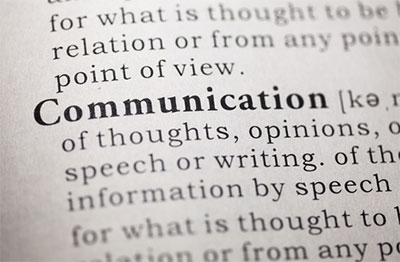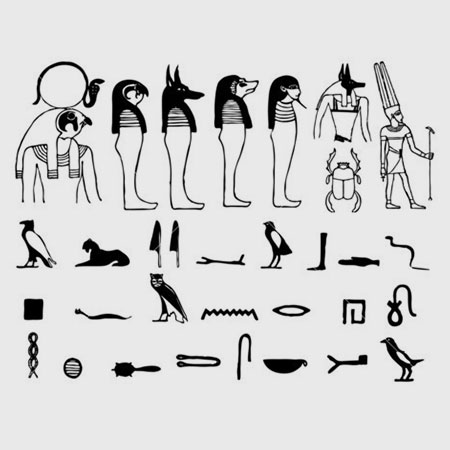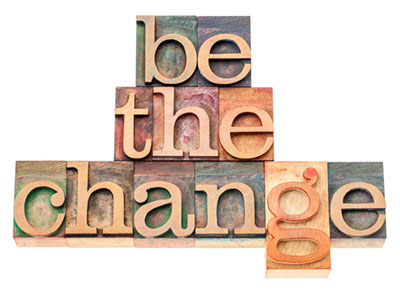
To truly create a way of life based on partnership rather than domination, it’s vital that we be aware of the underlying messages in the very words and metaphors we have been taught. If we aren’t, our good intentions may be undermined by the language we inherited, much of which often keeps us trapped in the belief that our only alternatives are dominating or being dominated.
Speaking the Language of Partnership
“Saying is believing.” Language both shapes and reflects consciousness, revealing a culture’s deepest beliefs and values. It’s very hard to talk about concepts for which we have no vocabulary. And the words we do have determine how we think about the people, ideas, and phenomena those words describe.
In some cultures, subordinates must use a different way of speaking when they address a “superior.” For example, traditional Japanese women have had to address men that way. There is also body language. So to this day, in some African tribes women have to kneel when addressing a male.
Most of the languages spoken today have elements that are our heritage from earlier more domination-oriented times. In the Latin-based languages, such as Spanish, French, Portuguese, and Italian, the language is so gendered that it is almost impossible to find a gender-neutral way of speaking. English is more malleable, and what follows shows what each one of us can do start speaking the language of partnership.
The Challenge of Language: Teaching the Language of Partnership
Adapted from an article by Lethea F. Erz, PhD. in The Partnership Way: New Tools for Living and Learning, 2nd ed. by Riane Eisler and David Loye.
The Issue of Inclusion
At this point in time, many of us notice the inappropriate use of “mankind” when what is really meant is “humankind”- both women and men. Most of the old “male-generic” nouns – which supposedly included women but in fact rarely did – have been replaced by neutral descriptors: “people,” “firefighters,” “mail carriers,” “sales representative” or “staff, “committee chair,” and so on.
The Problem of Pronouns
Most people are now aware of alternatives such as “s/he,” “she or he” (used equally with “he or she”), and the singular “they/them/their” (which is also gradually reclaiming grammatical legitimacy as a non-sexist alternative to gendered pronouns). Direct address (“you/your”) and the inclusive “we/our” are also useful in many situations.
The Colors of Racism
It’s important to examine language that implies something evil about “darkness” or “blackness.” Even when used without conscious racist intent, such terms as “black-hearted villain” or “deep dark secret,” contrasted with “white knight” or “innocent white lie,” contribute to the fear and demonization of dark-skinned people. It’s important to consider that in many ancient cultures, black was celebrated as the color of the rich fertile earth, while the white color of bones was associated with death.
The Healing Metaphor
Sexism, racism, and other forms of inequality and oppression stem from the idea that our only alternatives in a conflict are dominating or being dominated, with the winners dominating the losers. People are divided into groups labeled “us” and “other.” A major goal of partnership is moving from this “either/or” thinking to “both/and” conflict-resolution.
Yet many of our everyday expressions are metaphors of combat and warfare, which in addition to asserting that one side must win and the other lose, also imply that violence is an acceptable way of dealing with challenges.

When politicians launch a “war against drugs,” they are perpetuating this mindset. What a different image is conjured by speaking of “healing addictions” rather than “fighting drugs”! Instead of “fighting” and “defeating” and “winning” we might attempt “healing social ills” or “resolving” our problems. Rather than using language of mastery, control, domination, opposition, or violent competition, we could use metaphors of birth, growth, creation, harmony, construction, transformation, journeying, healing, helping, loving, nurturing, cooperation and connection—all of which implant much healthier images in the unconscious mind.
Subtle-Yet-Powerful Aspects of Language
Man-Made Language
Power is always an issue in the way things are named and labeled. In the domination cultures that shaped modern English, the men on top controlled writing and printing and the “rules” of language. Therefore, these men’s perceptions and values are reflected in how things are named. Often, words associated with maleness have lofty, important meanings, while words associated with femaleness imply inferiority or pathology. For example, contrast “seminal” ideas with “hysterical” ideas; both adjectives come from the human reproductive system, but what a difference in meaning between the male and the female! Another example: “master” (a person of great competency) and “mistress” (a man’s illicit paramour).

The above examples of non-parallel terms reflect male power to name and define. So do gender-associated words that have no parallels for the other sex. Try to think of a female equivalent of “emasculated” or “virile.” Or a parallel word for “feisty” or “dainty” that would apply to a man. What terms derived from female genitals are parallel in solemnity and importance to “testimony” or “testament” (derived from testes).
Animal names are also used to describe males and females in non-parallel ways. Those applied to women are often degrading or sexualized (heifer, filly, chick, dog, shrew, pig, sow, beaver, old crow, bunny, bitch, bat, fox, cold fish, hen, vixen, cat, kitten – usually paired with “sex”), while those applied to men frequently reflect power, virility, and cunning (buck, bull, stag, stallion, wolf). “Miss” and “Mrs.” are traditional female “courtesy titles” that have no parallel male term. The title “Ms.” has been adopted by many women since the 1970’s as a parallel for “Mr.” since neither “Mr.” nor “Ms.” provides information about an individual’s marital status. Language scholar Jackie Young writes: “It is our culture and communication system that constructs-and constricts-our reality, and if the male culture controls that system, then our reality is created and shaped (constricted) by male perceptions.” (1992, p. 98).
Seeing the Invisible and Creating the Nonexistent
In a partnership-oriented language, surely we would have more than one four-letter word (“love”) to describe such varied forms of affection as romantic passion, long-standing friendship, the devotion of a long-married couple, the feeling of parent for child, the reverence of child for parent, the attachment of people and pets, enthusiasm for skiing, or a taste for vanilla ice cream! What does it say about our culture that we have no single word for sexual intercourse that is neither clinical, violent, or taboo, yet we have so many different and graphic words to describe conflict and killing? Why are our most “obscene” oaths and expletives so often words for female sex organs or violent acts of dominator sex?
In addition to spoken and written language, it’s important to pay attention to non-verbal communications – the “language” of behaviors such as eye contact, paying attention, changing the subject, interrupting, questioning, body movements, tone of voice, and “holding the floor” longest in conversation. In a partnership-oriented society, these behaviors would be evidenced fairly equally among women and men, and among people of different ages, races, or appearance. When they are not, it’s likely that dominator dynamics are at work.

Transforming Language
How can we change language to reflect a partnership orientation? Awareness, as discussed above, is a first step. Often it’s possible to find less-common but still perfectly-serviceable words right in the English language. Using these words in place of commonly-used terms and expressions can create surprise in listeners, which in turn prompts them to listen more closely to the meaning of what we’ve actually said, and to contrast it with the meanings of the words we didn’t say (but they expected). If there isn’t a readily-available alternative to androcentric or sexist or racist or ageist language, it’s sometimes possible to playfully invent a word or expression whose meaning is perfectly clear and which calls attention to the problems inherent in the words not used. A woman might describe writing her last will and “ovariment.” Or one might speak of “senior singles” to replace “old maids.” Such words, like “foremother” or “waitperson” may eventually find their way into general use; “Ms.” has already done so. Although “prescriptive grammarians” (people whose goal is to define and enforce the rules of “proper” English) may be apoplectic about it, English is a living language, and we are perfectly free to make up new words, from “scratch” or by creative combining, as long as their meaning is clear.
Speaking of Language
To even speak of “partnership” itself – in a way that recognizes the centrality of the female/male relationship to all forms of social organization – requires the invention of new words. Riane Eisler coined the term “gylany” to describe equal linking between men and women, rather than the hierarchical ranking of either patriarchy or matriarchy. While “partnership” is used here because of its familiarity to most people, it has the disadvantage of having other meanings (alliance, for example).

“Gylany” is a more precise, but less-familiar term. Perhaps if it is used enough it will enter common usage, but in the meantime “partnership” gets the basic idea across, with less explanation. This is an example of the kind of trade-off that is often necessary in our efforts to change language and consciousness.
“Gy” comes from the Greek “gyne,” or woman; “an” comes from “andros,” or man. The “l” that links them comes from “lyein” or “lyo” which has double meanings in Greek: “to solve or resolve” (as in analysis) and “to dissolve or set free” (as in catalysis), and it also stands for the l in linking. (From Eisler, Riane (1987). The Chalice & the Blade: Our History, Our Future. San Francisco: Harper & Rowe, p. 105.
The adjectives “sexist,” “racist,” “ageist,” and “homophobic” are relatively recent inventions of the English language, created to describe attitudes of inequality which once were taken for granted as “natural.” “Sexism” implies that one sex is better than the other, “racism” infers superior and inferior races, and so on. Language which is sexist, racist, ageist, and homophobic is often fairly obvious and easy to spot, once one understands the concepts. But language can lack direct implications of inferiority, yet still promote inequality. Without being overtly sexist, it may be “androcentric”- treating male experience and perceptions as the norm, while ignoring or trivializing female experience. A quote from famous anthropologist Levi-Strauss is a perfect (if rather extreme) example of androcentrism: “All the people departed the next morning, leaving the women and children behind in the deserted village.” Who are considered “people” in this statement, and who are not?
While religious language is not a major part of public school curriculum, in our private lives it’s worth noting the androcentrism in “god-talk.” With the exception of the growing “women’s spirituality” movement and reform movements in several major monotheistic religions, traditional references to deity still use male terms. Some questions to consider: in a partnership-oriented culture, what would be considered sacred, and how would we discuss it? For reflections on this, see Riane Eisler’s book Sacred Pleasure. Would a supreme being be gendered at all, and would only one sex have a direct line to it in a priesthood that excludes women, as in traditional religions?

The Challenge of Change
In linguist Suzette Haden Elgin’s visionary novel, Native Tongue (1984), women create their own language to express female perceptions and concerns which are not represented in their domination culture’s common language. It eventually causes completely unforeseen changes in consciousness, which affect every aspect of their lives.
Trying to understand how this could have happened, one of the characters plaintively asks: “How can you plan for a new reality when you don’t have the remotest idea what it would be like?” The answer is, of course, that you can’t – no science exists that can predict a new-paradigm world from within the old one. So perhaps we can’t completely predict what far-ranging effects a language of partnership might have on our individual consciousness or on our society. But we can see how the language and culture of domination and violence reinforce each other, and how continuing to speak in these terms can only bring us more of the same.
We can ask: what might children be like who’ve learned to speak in terms of creating and nurturing and healing instead of fighting and defeating and dominating? We can try presenting them with words and pictures (and experiences) of peace and pleasure and partnership, of art and music and dance, of love and sharing and caring – and we can watch what happens. If we can even begin to imagine a world which respects and celebrates all life’s diversity-and if we can educate our children with words and images and metaphors that describe this vision, perhaps our children will be the ones to bring our vision to life!
For a more in-depth discussion on language and partnership, please read The Power of the Creative Word.
Common Words and Phrases and their Partnership Alternatives
“How can you plan for a new reality when you don’t have the remotest idea what it would be like?” The answer is, of course, that you can’t – no science exists that can predict a new-paradigm world from within the old one. But we can see how the language and culture of domination and violence reinforce each other, and how continuing to speak in these terms can only bring us more of the same.
Adapted from the article by Lethea F. Erz, PhD, “The Challenge of Language: Teaching the Language of Partnership” in The Partnership Way: New Tools for Living and Learning, 2nd ed. by Riane Eisler and David Loye.
Glossary of Partnership Terms
An invaluable compilation of the language of domination vs. the language of partnership by Stefano Mercanti, PhD. (Source: International Journal of Partnership Studies)


